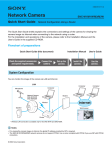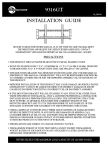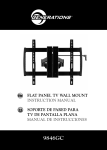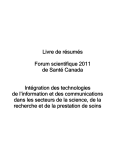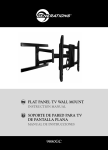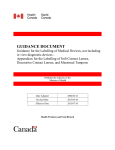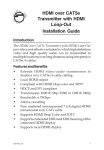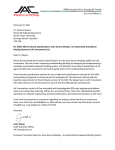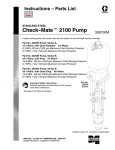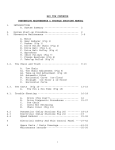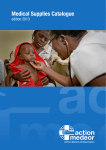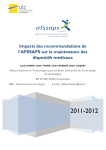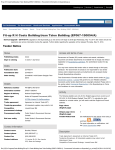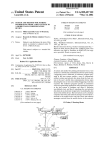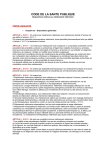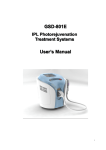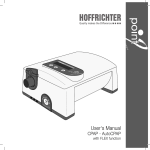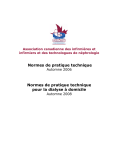Download Guidance for the Labelling of Medical Devices under Section 21 to
Transcript
Therapeutic Products Directorate Medical Devices Bureau 2934 Baseline Road, Tower B Address Locator: 3403A Ottawa, Ontario K1A 0K9 June 12, 2004 To: All Stakeholders RE: Guidance for the Labelling of Medical Devices under Section 21 to 23 of the Medical Devices Regulations, Appendices for Labelling: Soft Contact Lenses and Menstrual Tampons Please find attached the finalized Guidance for the Labelling of Medical Devices under Section 21 to 23 of the Medical Devices Regulations. The Medical Devices Regulations set out the requirements governing the sale, importation and advertisement of medical devices. The goal of the Regulations is to ensure that medical devices distributed in Canada are safe, effective, and meet quality standards. This guidance document sets out the Therapeutic Product Directorate’s guidance for industry on the subject. It is being provided now to assist manufacturers in understanding and complying with the regulatory requirements for labelling a medical device other than an in vitro diagnostic device. This will help ensure that the label provides the user with the information required to choose the device which meets his/her needs and to use it safely and effectively. The appendices to this document serve as additional labelling guidance for soft contact lenses and menstrual tampons. The document has been revised with the major changes being: • the Appendices on medical gloves and contraceptive devices have been removed as Policies exist which handle these products; • an “Ultra absorbency” category has been added to Appendix 2 on menstrual tampons. This guidance document is available on the Therapeutic Products Directorate website at: http://www.hc-sc.gc.ca/dhp-mps/md-im/applic-demande/guide-ld/labl_etiq_dv10-eng.php For more information on how to label devices please contact: Device Licensing Services Division Telephone: (613) 954-0285 Facsimile: (613) 957-6345 email: [email protected] Yours sincerely, Attachments Original Signed By: Robert G. Peterson, MD, PhD, MPH Director General GUIDANCE FOR INDUSTRY Guidance for the Labelling of Medical Devices under Sections 21 to 23 of the Medical Devices Regulations, Appendices for Labelling: Soft Contact Lenses and Menstrual Tampons Published by authority of the Minister of Health Date Adopted 2004/06/12 Effective Date 2004/09/12 Health Products and Food Branch Guidance Document Our mission is to help the people of Canada maintain and improve their health. Health Canada HPFB’s Mandate is to take an integrated approach to the management of the risks and benefits to health related to health products and food by: • Minimizing health risk factors to Canadians while maximizing the safety provided by the regulatory system for health products and food; and, • Promoting conditions that enable Canadians to make healthy choices and providing information so that they can make informed decisions about their health. Health Products and Food Branch LET YOUR COMPUTER DO THE SEARCHING! ... Need to know how to market a new device/drug in Canada? ... Want information on the device/drug regulatory process? ... Need to know what the newest devices/drugs on the Canadian market are? ... Want direct access to forms and policies? ... Need to know the requirements for labelling devices/drugs? All this and more is available on the Therapeutic Products Directorate / Biologics and Genetic Therapies Directorate / Marketed Health Products Directorate Website (s) at http://www.hc-sc.gc.ca/ahc-asc/branch-dirgen/hpfb-dgpsa/tpd-dpt/index-eng.php http://www.hc-sc.gc.ca/dhp-mps/brgtherap/index-eng.php © Minister of Public Works and Government Services Canada 2004 Available in Canada through Health Canada - Publications Brooke Claxton Building, A.L. #0913A Tunney's Pasture Ottawa, Ontario K1A 0K9 Tel: (613) 954-5995 Fax: (613) 941-5366 Également disponible en français sous le titre : Directive concernant l’étiquetage des instruments médicaux conformément aux articles 21 à 23 du Règlement sur les instruments médicaux, Annexes relatives à l’étiquetage: lentilles cornéennes souples, tampons hygiéniques, moyens anticonceptionnels et gants médicaux Health Canada Guidance for Industry Guidance for the Labelling of Medical Devices FOREWORD Guidance documents are meant to provide assistance to industry and health care professionals on how to comply with the policies and governing statutes and regulations. They also serve to provide review and compliance guidance to staff, thereby ensuring that mandates are implemented in a fair, consistent and effective manner. Guidance documents are administrative instruments not having force of law and, as such, allow for flexibility in approach. Alternate approaches to the principles and practices described in this document may be acceptable provided they are supported by adequate scientific justification. Alternate approaches should be discussed in advance with the relevant program area to avoid the possible finding that applicable statutory or regulatory requirements have not been met. As a corollary to the above, it is equally important to note that Health Canada reserves the right to request information or material, or define conditions not specifically described in this guidance, in order to allow the Department to adequately assess the safety, efficacy or quality of a therapeutic product. Health Canada is committed to ensuring that such requests are justifiable and that decisions are clearly documented. This document should be read in conjunction with the accompanying notice and the relevant sections of other applicable guidances. Date Adopted: 2004/06/12 Health Canada Guidance for Industry Guidance for the Labelling of Medical Devices TABLE OF CONTENTS Purpose . . . . . . . . . . . . . . . . . . . . . . . . . . . . . . . . . . . . . . . . . . . . . . . . . . . . . . . . . . . . . . . . . . . . . . 1 Background . . . . . . . . . . . . . . . . . . . . . . . . . . . . . . . . . . . . . . . . . . . . . . . . . . . . . . . . . . . . . . . . . . 1 Scope . . . . . . . . . . . . . . . . . . . . . . . . . . . . . . . . . . . . . . . . . . . . . . . . . . . . . . . . . . . . . . . . . . . . . . . 1 Definitions . . . . . . . . . . . . . . . . . . . . . . . . . . . . . . . . . . . . . . . . . . . . . . . . . . . . . . . . . . . . . . . . . . . 1 1.0 Interpretation of the Regulations . . . . . . . . . . . . . . . . . . . . . . . . . . . . . . . . . . . . . . . . . . . 3 1.1 Section 21 of the Medical Devices Regulations - General Labelling Reguirements . . 3 Section 21(1)(a) - The name of the device . . . . . . . . . . . . . . . . . . . . . . . . . . . . . . 3 Section 21(1)(b) - The name and address of the manufacturer . . . . . . . . . . . . . . . 3 Section 21(1)(c) - The identifier of the device . . . . . . . . . . . . . . . . . . . . . . . . . . . 4 Section 21(1)(d) - Control number in the case of a Class III or Class IV device . 4 Section 21(1)(e) - If the contents are not readily apparent, an indication of what the package contains . . . . . . . . . . . . . . . . . . . . . . . . . . . . . . . . 4 Section 21(1)(f) - The word “Sterile” if the manufacturer intends the device to be sold in a sterile condition . . . . . . . . . . . . . . . . . . . . . . . . . . . . . 4 Section 21(1)(g) - The expiry date of the device . . . . . . . . . . . . . . . . . . . . . . . . . . 5 Section 21(1)(h) - Unless self-evident to the intended user, the medical conditions, purposes and uses for which the device is manufactured . . . . 5 Section 21(1)(i) - The directions for use . . . . . . . . . . . . . . . . . . . . . . . . . . . . . . . 5 Section 21(1)(j) - Describe any special storage conditions . . . . . . . . . . . . . . . . . 7 Section 21(2) - The information required pursuant to section 21(1) of the Regulations shall be expressed in a legible, permanent and prominent manner . . . . . . . . . . . . . . . . . . . . . . . . . . . . . . . . . . 7 1.2 Section 22 of the Medical Devices Regulations - Outer Package Labelling for Sale to the General Public . . . . . . . . . . . . . . . . . . . . . . . . . . . . . . . . . . . . . . . . . . . . . . . . . 7 Section 22(1)(a), (b) Labelling for devices intended to be sold to the general public . . . . . . . . . . . . . . . . . . . . . . . . . . . . . 7 Section 22(2) - Labelling for devices too small to display all the required information . . . . . . . . . . . . . . . . . . . . . . . . . . . . . . . . . . . . . . . . 7 1.3 Section 23 of the Medical Devices Regulations - Language Labelling Requirements 7 Section 23(1), (2), (3) - Official Language Requirements . . . . . . . . . . . . . . . . . . . 7 2.0 Bibliography . . . . . . . . . . . . . . . . . . . . . . . . . . . . . . . . . . . . . . . . . . . . . . . . . . . . . . . . . . . 8 Appendix 1 - Labelling for Soft Contact Lenses . . . . . . . . . . . . . . . . . . . . . . . . . . . . . . . . . . . . . . 9 Appendix 2 - Labelling for Menstrual Tampons . . . . . . . . . . . . . . . . . . . . . . . . . . . . . . . . . . . . . 11 Date Adopted: 2004/06/12 Health Canada Guidance for Industry Guidance for the Labelling of Medical Devices Purpose This guidance document is intended to assist manufacturers in understanding and complying with the regulatory requirements for labelling a medical device under the new Medical Devices Regulations (Regulations). Background Sections 21 to 23 of the new Medical Devices Regulations specify how medical devices shall be labelled in Canada. In response to requests by manufacturers this document has been prepared to explain the labelling requirements within the intent of the Regulations. In addition to this guidance document, the Appendices serve as labelling guidance for soft contact lenses and menstrual tampons. All published Policy and Guidance Documents can be found on the Therapeutic Products Directorate (TPD) website: http://www.hc-sc.gc.ca/dhp-mps/md-im/applic-demande/guide-ld/index-eng.php Scope The labelling requirements apply to all medical devices offered for sale in Canada or imported for sale or use in Canada. These labelling requirements do not apply to custom-made, special access devices, nor investigational testing devices. Specific labelling requirements for these types of licence applications are described in the guidance documents entitled How to Apply for Authorization to Obtain Custom-Made or Special Access Devices, and Preparation for an Application for Investigational Testing- Medical Devices. Guidance on labelling for in vitro diagnostic devices can be found in a separate document entitled Guidance for the Labelling of In Vitro Diagnostic Devices. Definitions The following definitions were created to guide and explain technical terms specific to this guidance document: ADVERSE EFFECT is an undesirable effect, usually seen in clinical studies, and has associated frequency data. (Réaction indésirable) CAUTIONS AND PRECAUTIONS are pieces of information which alert the user to exercise special care necessary for the safe and effective use of the device. (Mises en garde et avertissements) CONTRAINDICATIONS describe situations where the device should not be used because the risk of use clearly outweighs any foreseeable benefits. (Contre-indications) CONTROL NUMBER means any distinctive symbols, such as a distinctive combination of letters or numbers, or both, from which the history of the manufacturing, packaging, labelling, and distribution of a unit, lot, or batch of finished devices can be determined (Medical Devices Regulations). (Numéro de contrôle) Date Adopted: 2004/06/12 1 Health Canada Guidance for Industry Guidance for the Labelling of Medical Devices DIRECTIONS FOR USE for a medical device means full information as to the procedures recommended for achieving the optimum performance of the device, and includes CAUTIONS, WARNINGS, CONTRAINDICATIONS, and possible ADVERSE EFFECTS (Medical Devices Regulations). (Mode d’emploi) INDICATIONS FOR USE is a general description of the disease(s) or condition(s) the device will diagnose, treat, prevent or mitigate, including where applicable a description of the patient population for which the device is intended. The indications include all the labelled uses of the device, for example the condition(s) or disease(s) to be prevented, mitigated, treated or diagnosed, part of the body or type of tissue applied to or interacted with, frequency of use, physiological purpose and patient population. The indications for use are generally labelled as such, but may also be inferred from other parts of the labelling, including the DIRECTIONS FOR USE, PRECAUTIONS, WARNINGS and bibliography sections. (Indications d’emploi). LABEL includes any legend, word or mark attached to, included in, belonging to or accompanying any food, drug, cosmetic, device or package (Food and Drugs Act). (Étiquette) IDENTIFIER means a unique series of letters or numbers or any combination of these or a barcode that is assigned by the manufacturer and that identifies it and distinguishes it from similar devices (Medical Devices Regulations). (Identificateur) NAME OF THE DEVICE in respect of a medical device, includes any information necessary for the user to identify the device and to distinguish it from similar devices (Medical Devices Regulations). (Nom de l’instrument) PACKAGE includes any thing in which any food, drug, cosmetic or device is wholly or partly contained, placed or packed (Food and Drugs Act). (Emballage) SELL includes offer for sale, expose for sale, have in possession for sale and distribute, whether or not the distribution is made for consideration (Food and Drugs Act). (Vendre) WARNING describes serious adverse reactions and potential safety hazards that can occur in the proper use, or misuse, of a device, along with the consequent limitations in use and mitigating steps to take if they occur. (Avertissement) Date Adopted: 2004/06/12 2 Health Canada Guidance for Industry Guidance for the Labelling of Medical Devices 1.0 Interpretation of the Regulations All medical devices must have a LABEL which provides the information specified in Section 21(1), (a) to (j) of the Regulations. The definition of LABEL as defined in the Food and Drugs Act allows flexibility in that the information need not be affixed to the device but may be provided with the device as, for example, PACKAGE inserts, brochures or leaflets. 1.1 Section 21 of the Medical Devices Regulations - General Labelling Requirements Section 21(1)(a) - The name of the device Each device including a system, medical device group, medical device family, or medical device group family must have a name. The device licence is issued to the name on the LABEL which may describe one device, an administrative grouping of devices sold for convenience under a single name or a grouping of devices that carry the same generic name specifying the intended use of devices. This name permits the user to identify it and distinguish it from other devices or device types. For example: Acme Monofil Nylon Suture J. Doe Double Lumen Haemodialysis Catheter Mary Doe Intraocular Lenses, or T-Pack Procedure Kit (procedural packs) Section 21(1)(b) - The name and address of the manufacturer In the Regulations, “manufacturer” means a person who SELLs the medical device under their name, or under a trade mark, design, trade name or other name or mark owned or controlled by the person, and who is responsible for designing, manufacturing, assembling, processing, labelling, packaging, refurbishing or modifying the device, or for assigning to it a purpose, whether those tasks are performed by that person or on their behalf. The licence is issued to the manufacturer named on the LABEL. The Regulations do not require nor prevent the name and address of any other person such as the importer or the distributor to be on the LABEL also. If more than one name appears on the LABEL, the relationship of each name to the device must be made clear. There may be private labelling agreements between the fabricator and the distributor or importer where the distributor or importer name and product name appear on the LABEL. In this case, the name and address on the LABEL, by definition, becomes the manufacturer. The device licence is issued to the manufacturer named on the LABEL. Further, the named manufacturer is required to satisfy the safety and effectiveness requirements applicable to the “manufacturer.” It is not acceptable for the solely named manufacturer on the LABEL to be preceded by words such as “imported by”, “distributed by”. The name and address should be in sufficient detail to serve as a postal address. Date Adopted: 2004/06/12 3 Health Canada Guidance for Industry Guidance for the Labelling of Medical Devices Section 21(1)(c) - The identifier of the device, including the identifier of any medical device that is part of a system, medical device group, medical device family or medical device group family The IDENTIFIER is a unique number assigned to the device by the manufacturer, which along with the NAME OF THE DEVICE, will permit a device to be distinguished from all other devices. It may be a catalogue number, model number, or a barcode and will permit, in combination with the name, a certain level of control and traceability in the market place. For example: Acme Monofil Nylon Suture Catalogue # 23114 Acme Monofil Nylon Suture Catalogue # 23115 Section 21(1)(d) - Control number in the case of a Class III or Class IV device The CONTROL NUMBER means any distinctive symbols, such as a distinctive combination of letters or numbers, or both, from which the history of the manufacturing, packaging, labelling or distribution of a unit, lot or batch of finished devices can be determined. Rather than define both lot number and serial number as was done in the old Regulations, the Directorate has chosen to adopt CONTROL NUMBER, a term which is broad in scope, and encompasses both lot and serial numbers. The CONTROL NUMBER allows the device to be traced from manufacture to the end user, including an individual in whom the device may have been implanted. Along with the NAME OF THE DEVICE and the IDENTIFIER, it provides the highest degree of traceability. This is a requirement for Class III and Class IV devices only. Although not mandatory for Class I and Class II devices, the CONTROL NUMBER enhances postmarket traceability. Section 21(1)(e) - If the contents are not readily apparent, an indication of what the package contains, expressed in terms appropriate to the device, such as the size, net weight, length, volume or number of units The intent of this requirement is to provide specific information describing the package contents to the user and to enable the user to make an informed choice when comparing similar devices. The information will also allow the user to pick a size suitable for his purposes. Units should be expressed in metric or SI units (International System of Units). For example, the LABEL for a surgical procedure pack should describe its contents giving a full list of the device and non-device components. The user is then informed of the suitability and completeness of the pack for the procedure to be performed. In the case of devices containing natural rubber latex, this material should be identified. Section 21(1)(f) - The word “Sterile” if the manufacturer intends the device to be sold in a sterile condition If the device is sterilized by the manufacturer and the manufacturer means it to be sold in a sterile condition, the word “Sterile” must appear on the LABEL. The absence of the word “sterile” indicates that the device is not meant to be made available to the user in a sterile condition. Date Adopted: 2004/06/12 4 Health Canada Guidance for Industry Guidance for the Labelling of Medical Devices Section 21(1)(g) - The expiry date of the device, if the device has one, to be determined by the manufacturer based on the component of the device that has the shortest projected useful life The life of the least stable component determines the expiration date. The expiration date must be based on the results of studies which demonstrate that the device will perform as intended and will meet its specifications until that date. The date should be expressed in the internationally accepted format (ISO 8601:1988 Data Elements and Interchange Formats-Information Exchange-Representation of Dates and Times): year (in four digits), month (in two digits), and day (in two digits). The separator for the three portions of the date should be a hyphen (-). Section 21(1)(h) - Unless self-evident to the intended user, the medical conditions, purposes and uses for which the device is manufactured, sold or represented, including the performance specifications of the device if those specifications are necessary for proper use This section requires the manufacturer to state succinctly what the device is intended to do and on which population subgroup the device is intended to be used, for example, "For use in adults over 18 years of age." The purposes and uses refer to the function of the device as well as the objective intent of the manufacturer. This intent may be communicated by the labelling claims, by advertising, written or oral statements made by the manufacturer or representatives. There are some devices for which the INDICATIONS FOR USE are commonly understood, and such labelling may not be necessary. For example, it may not be necessary to state that use of an ordinary toothbrush will help prevent tooth decay. There are certain surgical instruments whose uses are obvious to the intended user, such as a stainless steel scalpel. Other examples are non-medicated adhesive bandages or tongue depressors. The detail and level of the language used should be appropriate to the educational level or expertise of the intended user. The purposes and uses must be supported by valid scientific evidence that the device, as labelled, will provide clinically significant results. In the case of Class III and Class IV devices, the manufacturer may wish to include a summary of pre-clinical or investigational testing results with appropriate references. Section 21(1)(i) - The directions for use, unless directions for use are not required for the device to be used safely and effectively Refer to the Definitions section for DIRECTIONS FOR USE. This is the information supplied to the lay person and/or the health care professional enabling these persons to use the device without causing unnecessary harm to themselves or another person and to achieve the desired result. The DIRECTIONS FOR USE should be written at a level commensurate with the training of the expected users. For some more complex, active or powered devices, the DIRECTIONS FOR USE may require a special Surgeon's Instruction Manual, Operator's Manual, and a User's Manual. Date Adopted: 2004/06/12 5 Health Canada Guidance for Industry Guidance for the Labelling of Medical Devices If the device is an implant listed in Schedule 2 of the Regulations, the manufacturer is required to include two implant registration cards, as detailed in Sections 66 and 67. A signed Patient Consent Form with patient information should also be included. Refer to the Definitions section for additional information on the following terms: Adverse Effects This section should list the ADVERSE EFFECTs that have been reported in association with the use of the device. A description and the frequency of the most serious ADVERSE EFFECTs should also be provided. Contraindications CONTRAINDICATIONS are conditions, especially any condition of disease, which render some particular line of treatment improper or undesirable. This section should describe situations in which the device should not be used because of risk which outweighs any potential therapeutic benefit. Examples might be "Contraindicated for use in pregnancy", or "Not to be used in a patient who has an implanted Cardiac Pacemaker/Defibrillator.” Warnings and Cautions To warn is to give notice beforehand, especially of danger. WARNINGS describe serious adverse and potential safety hazards that can occur in the proper use, or misuse, of a device, along with consequent limitations in use and mitigating steps to take if they occur. For example: ‘ CAUTION: The operation of this implantable cardioverter/defibrillator may be affected by the electromagnetic fields produced by anti-theft systems and metal detectors. ‘ CAUTION: The risk of meningitis may increase in cochlear implant recipients. If animal or potentially infectious material is used during the manufacturing process, the LABEL should state: "Warning, this product contains material of human (or animal) origin which may have the potential to cause disease." The instructions should include Disposal Instructions, such as "Material of human (or animal) origin, incinerate or sterilize before disposal." It is suggested that in a case where a condition or circumstance may result in death or serious injury a succinctly worded WARNING enclosed within a distinctive visual box contained within the labelling should be provided. CAUTIONS: This term is sometimes referred to as “ PRECAUTIONS”. CAUTIONS should be written to get the user’s attention, to inform of the seriousness of the hazard, and to recommend steps to avoid the hazard. For example, exposure to the radiofrequency (RF) signals from a cellular telephone may cause malfunction of a recording device or a cardiac pacemaker. The CAUTIONS should advise the telephone user of a safe distance outside which the device and telephone may be used. Date Adopted: 2004/06/12 6 Health Canada Guidance for Industry Guidance for the Labelling of Medical Devices Section 21(1)(j) - Describe any special storage conditions applicable to the device Some devices may deteriorate rapidly under certain environmental conditions e.g. temperature, humidity, light, and may need to be stored in a specified manner to prevent this deterioration. The user must be provided with this information in order to decide if such storage conditions are accessible or within their means. Storage temperatures should be provided in degrees Celsius. Section 21(2) - The information required pursuant to section 21(1) of the Regulations shall be expressed in a legible, permanent and prominent manner, in terms that are easily understood by the intended user All of the labelling items described in the sections above are required to be presented in a conspicuous and clear fashion on the LABEL. The LABEL information must be presented in a format most likely to be understood by the expected user. 1.2 Section 22 of the Medical Devices Regulations - Outer Package Labelling for Sale to the General Public Section 22(1)(a), (b) - Labelling for devices intended to be sold to the general public LABEL information must be set out on the outside of the package. The information must be visible to enable the intended user to make an informed choice in purchasing a device, and to permit the postmarket identification of a device during a product recall. Please refer to Appendices 1 and 2 for specific guidance on the labelling of soft contact lenses, menstrual tampons, contraceptive devices, and medical gloves. Section 22(2) - Labelling for devices too small to display all the required information This section recognizes that under some circumstances, the PACKAGE that contains the device may be too small to allow the DIRECTIONS FOR USE to be displayed. The DIRECTIONS FOR USE may then accompany the product as a PACKAGE insert. In these circumstances, information on the outside of the PACKAGE should refer the user to this further labelling. 1.3 Section 23 of the Medical Devices Regulations - Language Labelling Requirements Section 23(1), (2), (3) - Official Language Requirements Devices sold to the general public In respect of a medical device that is sold to the general public, the information required by paragraphs 21(1) (a) and (e) to (j) shall, as a minimum, be in both English and French. In such cases, the DIRECTIONS FOR USE must be supplied in both official languages at the time of purchase. All other devices Devices sold in Canada must be labelled in either English or French. Any other additional languages are also permitted. It should be noted that the DIRECTIONS FOR USE must be readily available in the other official language at the request of the purchaser. 2.0 Bibliography Date Adopted: 2004/06/12 7 Health Canada Guidance for Industry Guidance for the Labelling of Medical Devices 1. Food and Drugs Act. R.S. c. F-27, s.1. 2. Medical Devices Regulations, Chapter 871 Date Adopted: 2004/06/12 8 Health Canada Guidance for Industry Guidance for the Labelling of Medical Devices Appendix 1 - Labelling for Soft Contact Lenses 1.0 The outer LABEL of the package to display the correction factor of the contact lens. 2.0 The outer LABEL, or the package insert, to contain information indicating: (i) at least two lens care systems that are recommended by the manufacturer for the contact lens, (ii) a warning statement contraindicating the use of non-compatible lens care products, if applicable, (iii) a statement that the safety and effectiveness of contact lenses depends on proper use, (iv) that an eye care professional should be consulted regarding proper use, (v) the recommended period of continuous wear, expressed in hours or, in the case of a prolonged wear lens, in days, (vi) the minimum period the contact lens should be left out of the eye before re-insertion, (vii) the recommended number of times, if any, that the contact lens can be cleaned, (viii) that adequate follow-up by an eye care professional is essential for the safe use of the contact lens, (ix) that infection, with possible permanent damage to vision, could result from the failure to strictly follow recommended DIRECTIONS FOR USE and lens care procedures, (x) that an eye care professional should be consulted regarding the use of the contact lens in certain atmospheric or environmental conditions that can cause irritation to the eye, (xi) that in the event of an adverse reaction to the wearing of the contact lens, including discomfort to the eye, red eye and blurred vision, the user should immediately remove the contact lens and consult an eye care professional before resuming use, (xii) where the contact lens is a cosmetically tinted contact lens, a warning statement that the tinted contact lens can reduce visibility in low light conditions, (xiii) where the contact lens is a prolonged wear lens, a warning statement that users of extended-wear lenses have a higher risk of infection and permanent damage to their vision, and (xiv) where the soft contact lens is not a prolonged wear lens, a warning statement that the wearing of the contact lens while sleeping increases the risk of infection and permanent damage to vision. 3.0 Where the above information is displayed in a package insert, the following statement is to appear on the outer LABEL. “Attention: Read and save the enclosed information. Mise en garde: Veuillez lire et conserver les renseignements ci-joints.” In the context of the above discussion: “Contact lens” means a prosthetic device that covers the cornea, and may cover a portion of the limbus or the sclera, for the purpose of correcting refractive errors of the eye. “Eye care professional” means an optometrist, optician, physician or ophthalmologist. Date Adopted: 2004/06/12 9 Health Canada Guidance for Industry Guidance for the Labelling of Medical Devices “Lens care procedures” means procedures recommended by the manufacturer of a soft contact lens for storing the contact lens or for cleaning, rinsing, neutralizing or disinfecting the contact lens or the container in which it is stored. “Lens care product” means a product recommended by the manufacturer of a contact lens for storing the contact lens or for cleaning, rinsing, neutralizing or disinfecting the contact lens or the container in which it is stored. “Lens care system” means a group of lens care products that are intended to be used together to perform all lens care procedures appropriate for a specific type of contact lens. “Prolonged wear lens” means a soft contact lens that is designed to be worn, without removal, for 24 hours or longer. “Soft contact lens” means a contact lens that is manufactured from a flexible polymer material. Date Adopted: 2004/06/12 10 Health Canada Guidance for Industry Guidance for the Labelling of Medical Devices Appendix 2 - Labelling for Menstrual Tampons 1.0 An absorbency identification to appear on the display panel which is the part of the package that is displayed or visible under normal conditions of sale or advertisement to the consumer. This absorbency identification is found in column II of the following table, and it represents the range of absorbency of the menstrual tampon as set out in column I of the table. The absorbency of a menstrual tampon must be measured by an accepted test method. 2.0 Anywhere on the outer LABEL, the statement “ATTENTION: Tampons are associated with Toxic Shock Syndrome (TSS). TSS is a rare but serious disease that may cause death. MISE EN GARDE: Les tampons hygiéniques sont associés au syndrome de choc toxique (SCT). Le SCT se manifeste rarement, mais il n’en constitue pas moins une maladie grave qui peut être mortelle.” 3.0 Information provided on the LABEL or in a package insert, to: (i) Explain to the user the warning symptoms and risks of Toxic Shock Syndrome associated with the use of menstrual tampons, (ii) advise the user on the duration of use and proper hygiene during use, (iii) advise the user to use menstrual tampons with the minimum absorbency needed to control menstrual flow in order to reduce the risk of contracting Toxic Shock Syndrome, (iv) explain to the user the various ranges of absorbency, described in the following table and the corresponding absorbency identifications, of menstrual tampons sold, in Canada, by that manufacturer, (v) describe to the user how to compare the ranges of absorbency and the corresponding absorbency identifications to select the tampon with the minimum absorbency needed to control menstrual flow in order to reduce the risk of contracting Toxic Shock Syndrome, (vi) advise the user to seek medical attention before using menstrual tampons again if Toxic Shock Syndrome warning symptoms have occurred in the past, or if the user has any questions about Toxic Shock Syndrome, or tampon use, (vii) describe the material composition of the tampon - list the materials of manufacture, including additives, deodorants, wetting agents, and preservatives, and (viii) state that the tampon is bleached using an elemental chlorine-free method. 4.0 If the above information is provided in a package insert, the following statement is to appear on the outer LABEL, “Attention: Read and save the enclosed information. Mise en garde: Veuillez lire et conserver les renseignements ci-joints.” Date Adopted: 2004/06/12 11 Health Canada Guidance for Industry Guidance for the Labelling of Medical Devices Column I Column II Item Range of Absorbency (grams) Absorbency Identification 1 Less than or equal to 6 Light Absorbency 2 Greater than 6 less than 9 Regular Absorbency 3 Greater than 9 less than 12 Super Absorbency 4 Greater than 12 less than 15 Super Plus Absorbency 5 Greater than 15 up to 18 Ultra Absorbency Date Adopted: 2004/06/12 12

















